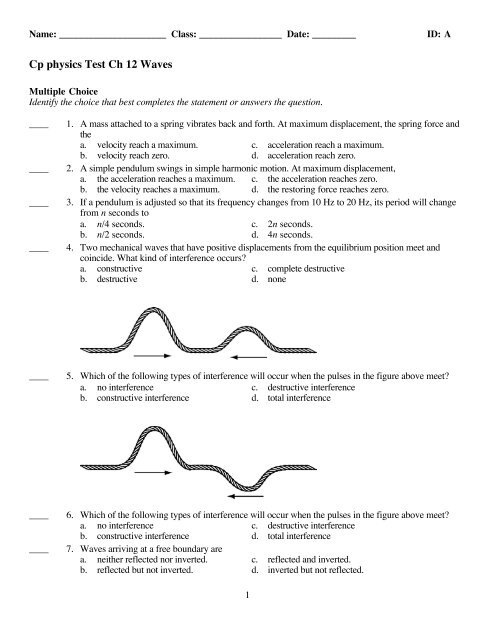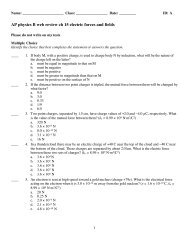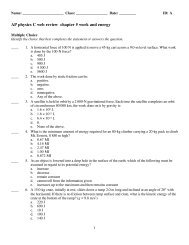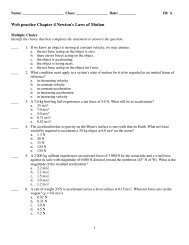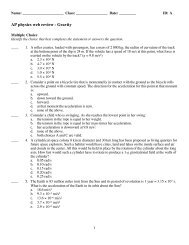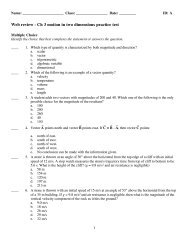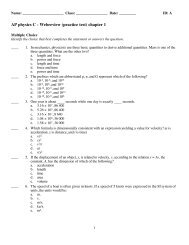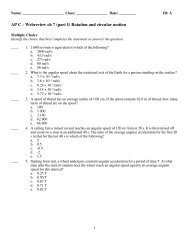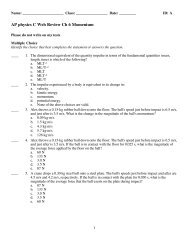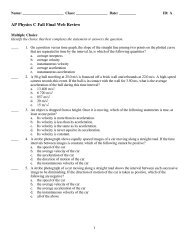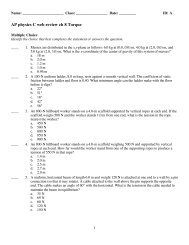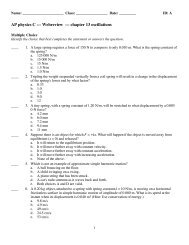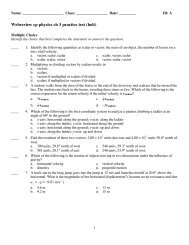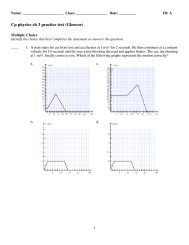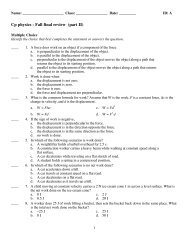Cp physics Test Ch 12 Waves
Cp physics Test Ch 12 Waves - Planet Holloway
Cp physics Test Ch 12 Waves - Planet Holloway
Create successful ePaper yourself
Turn your PDF publications into a flip-book with our unique Google optimized e-Paper software.
Name: ______________________ Class: _________________ Date: _________<br />
ID: A<br />
<strong>Cp</strong> <strong>physics</strong> <strong>Test</strong> <strong>Ch</strong> <strong>12</strong> <strong>Waves</strong><br />
Multiple <strong>Ch</strong>oice<br />
Identify the choice that best completes the statement or answers the question.<br />
____<br />
____<br />
____<br />
____<br />
1. A mass attached to a spring vibrates back and forth. At maximum displacement, the spring force and<br />
the<br />
a. velocity reach a maximum. c. acceleration reach a maximum.<br />
b. velocity reach zero. d. acceleration reach zero.<br />
2. A simple pendulum swings in simple harmonic motion. At maximum displacement,<br />
a. the acceleration reaches a maximum. c. the acceleration reaches zero.<br />
b. the velocity reaches a maximum. d. the restoring force reaches zero.<br />
3. If a pendulum is adjusted so that its frequency changes from 10 Hz to 20 Hz, its period will change<br />
from n seconds to<br />
a. n/4 seconds. c. 2n seconds.<br />
b. n/2 seconds. d. 4n seconds.<br />
4. Two mechanical waves that have positive displacements from the equilibrium position meet and<br />
coincide. What kind of interference occurs?<br />
a. constructive c. complete destructive<br />
b. destructive d. none<br />
____<br />
5. Which of the following types of interference will occur when the pulses in the figure above meet?<br />
a. no interference c. destructive interference<br />
b. constructive interference d. total interference<br />
____<br />
____<br />
6. Which of the following types of interference will occur when the pulses in the figure above meet?<br />
a. no interference c. destructive interference<br />
b. constructive interference d. total interference<br />
7. <strong>Waves</strong> arriving at a free boundary are<br />
a. neither reflected nor inverted. c. reflected and inverted.<br />
b. reflected but not inverted. d. inverted but not reflected.<br />
1
Name: ______________________<br />
ID: A<br />
____<br />
____<br />
____<br />
____<br />
____<br />
8. For a mass hanging from a spring, the maximum displacement the spring is stretched or compressed<br />
from its equilibrium position is the system’s<br />
a. amplitude. c. frequency.<br />
b. period. d. acceleration.<br />
9. A pendulum swings through a total of 28°. If the displacement is equal on each side of the<br />
equilibrium position, what is the amplitude of this vibration? (Disregard frictional forces acting on the<br />
pendulum.)<br />
a. 28° c. 56°<br />
b. 14° d. 7.0°<br />
10. Which of the following features of a given pendulum changes when the pendulum is moved from<br />
Earth’s surface to the moon?<br />
a. the mass c. the equilibrium position<br />
b. the length d. the restoring force<br />
11. Which of the following is a single nonperiodic disturbance?<br />
a. pulse wave c. sine wave<br />
b. periodic wave d. transverse wave<br />
<strong>12</strong>. One end of a taut rope is fixed to a post. What type of wave is produced if the free end is quickly<br />
raised and lowered one time?<br />
a. pulse wave c. sine wave<br />
b. periodic wave d. longitudinal wave<br />
____<br />
____<br />
____<br />
13. Which of the following types of interference will occur when the pulses in the figure above meet?<br />
a. no interference c. partial interference<br />
b. complete constructive interference d. complete destructive interference<br />
14. Consider two identical wave pulses on a rope having a fixed end. Suppose the first pulse reaches the<br />
end of the rope, is reflected back, and then meets the second pulse. When the two pulses overlap<br />
exactly, what will be the amplitude of the resultant pulse?<br />
a. zero<br />
b. same as the original pulses<br />
c. double the amplitude of the original pulses<br />
d. half the amplitude of the original pulses<br />
15. A student sends a pulse traveling on a taut rope with one end attached to a post. What will the student<br />
observe?<br />
a. The pulse will not be reflected if the rope is free to slide up and down on the post.<br />
b. The pulse will be reflected and inverted if the rope is free to slide up and down on<br />
the post.<br />
c. The pulse will be reflected and inverted if the rope is fixed to the post.<br />
d. The pulse will not be inverted if the rope is fixed to the post.<br />
2
Name: ______________________<br />
ID: A<br />
____<br />
16. A 2.0 m long stretched rope is fixed at both ends. Which wavelength would not produce standing<br />
waves on this rope?<br />
a. 2.0 m c. 4.0 m<br />
b. 3.0 m d. 6.0 m<br />
____<br />
17. How many nodes and antinodes are shown in the standing wave above?<br />
a. two nodes and three antinodes c. one-third node and one antinode<br />
b. one node and two antinodes d. three nodes and two antinodes<br />
____<br />
18. How many nodes and antinodes are shown in the standing wave above?<br />
a. four nodes and four antinodes c. four nodes and five antinodes<br />
b. four nodes and three antinodes d. five nodes and four antinodes<br />
Problem<br />
19. A mass on a spring that has been compressed 0.1 m has a restoring force of 20 N. What is the spring<br />
constant?<br />
20. A mass on a spring vibrates in simple harmonic motion at an amplitude of 8.0 cm. If the mass of the<br />
object is 0.20 kg and the spring constant is 130 N/m, what is the frequency?<br />
21. If a force of 50 N stretches a spring 0.10 m, what is the spring constant?<br />
22. Imagine that you could transport a simple pendulum from Earth to the moon, where the free-fall<br />
acceleration is one-sixth that on Earth. By what factor would the pendulum’s frequency be changed?<br />
Express the answer with one significant figure.<br />
23. On the planet Xenos, an astronaut observes that a 1.00 m long pendulum has a period of 1.50 s. What<br />
is the free-fall acceleration on Xenos?<br />
24. A student wishes to construct a mass-spring system that will oscillate with the same frequency as a<br />
swinging pendulum with a period of 3.45 s. The student has a spring with a spring constant of 72.0<br />
N/m. What mass should the student use to construct the mass-spring system?<br />
25. A periodic wave has a wavelength of 0.50 m and a speed of 20 m/s. What is the wave frequency?<br />
3
ID: A<br />
<strong>Cp</strong> <strong>physics</strong> <strong>Test</strong> <strong>Ch</strong> <strong>12</strong> <strong>Waves</strong><br />
Answer Section<br />
MULTIPLE CHOICE<br />
1. C<br />
2. A<br />
3. B<br />
4. A<br />
5. B<br />
6. C<br />
7. B<br />
8. A<br />
9. B<br />
10. D<br />
11. A<br />
<strong>12</strong>. A<br />
13. D<br />
14. A<br />
15. C<br />
16. B<br />
17. D<br />
18. D<br />
PROBLEM<br />
19. 200 N/m<br />
Given<br />
x = –0.1 m<br />
F elastic<br />
= 20 N<br />
Solution<br />
F elastic<br />
= –kx<br />
k = − F elastic<br />
= − 20 N<br />
x –0.1 m<br />
k = 200 N/m<br />
1
ID: A<br />
20. 4.0 Hz<br />
Given<br />
x = 8.0 cm (This value is not relevant to the problem.)<br />
m = 0.20 kg<br />
k = 130 N/m<br />
Solution<br />
T = 2π<br />
m<br />
k<br />
and f = 1 T , so<br />
f =<br />
2π<br />
1<br />
21. 500 N/M<br />
m<br />
k<br />
= 1 2π<br />
k<br />
m = 1 2π<br />
130 N/m<br />
0.20 kg<br />
= 4.1 Hz<br />
Given<br />
F elastic<br />
= 50 N<br />
x = –0.10 m<br />
Solution<br />
F elastic<br />
= –kx<br />
k = −F elastic<br />
= −50 N<br />
x −0.10 m<br />
k = 500 N/m<br />
2
ID: A<br />
22. 0.4<br />
Given<br />
a g<br />
= 1 6 g<br />
Solution<br />
T = 2π<br />
L<br />
a g<br />
Because L and 2π remain constant when the pendulum is<br />
moved to the moon,T moon<br />
∝<br />
acceleration of the moon.<br />
1<br />
a g<br />
,where a g<br />
is the gravitational<br />
1<br />
T moon<br />
T earth<br />
=<br />
a g<br />
1<br />
g<br />
=<br />
g<br />
a g<br />
f = 1 T , so f moon<br />
f earth<br />
=<br />
a g<br />
g = 1<br />
6 = 0.4<br />
23. 17.6 m/s 2<br />
Given<br />
L = 1.00 m<br />
T = 1.50 s<br />
Solution<br />
Ê<br />
T = 2π<br />
L<br />
, so T 2 = 4π 2 L ˆ<br />
a g<br />
a<br />
Ë<br />
Á g<br />
¯<br />
˜<br />
a g<br />
= 4π 2 L<br />
Ê<br />
= 4π 2 1.00 m ˆ<br />
2<br />
= 17.6 m/s<br />
T 2 Ë<br />
Á ( 1.50 s) 2<br />
¯<br />
˜<br />
3
ID: A<br />
24. 21.7 kg<br />
Given<br />
T pendulum<br />
= 3.45 s<br />
k = 72.0 N/m<br />
Solution<br />
If both systems have the same frequency, they will also have the same period.<br />
Therefore, the given period may be substituted into the equation for a mass-spring system.<br />
T = 2π<br />
m<br />
k<br />
Ê<br />
T 2 = 4π 2 m ˆ<br />
Ë<br />
Á k ¯<br />
˜<br />
3.45 s<br />
m = T 2 k ( ) 2 ( 72.0 N/m)<br />
4π 2 = 4π 2<br />
25. 40 Hz<br />
= 21.7 kg<br />
Given<br />
v = 20 m/s<br />
λ = 0.50 m<br />
Solution<br />
v = fλ<br />
f = v =<br />
20 m/s<br />
λ 0.50 m<br />
= 40 Hz<br />
4


